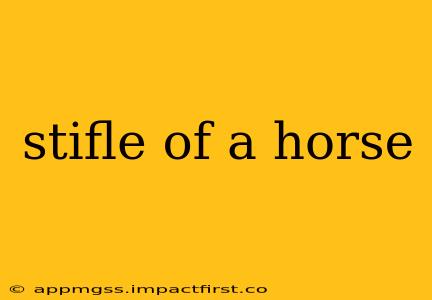The stifle joint in a horse is a complex and crucial structure, often compared to the human knee. Understanding its anatomy, common injuries, and treatment methods is vital for horse owners and equine professionals alike. This comprehensive guide delves into the intricacies of the equine stifle, providing insightful information for better care and management.
What is the Stifle Joint in a Horse?
The horse's stifle is the joint connecting the thigh (femur), the kneecap (patella), and the lower leg bones (tibia and fibula). It's a hinge joint allowing for flexion and extension, crucial for movement and locomotion. Unlike the human knee, the horse's stifle doesn't rotate. Its complex structure involves several ligaments, tendons, and muscles working in concert to support weight and facilitate movement. This intricate mechanism makes it susceptible to a variety of injuries.
What are Common Injuries to a Horse's Stifle?
Several factors can lead to stifle injuries, including strenuous exercise, trauma, and underlying conditions. Some of the most common stifle problems include:
- Stifle Injuries: This broad term encompasses various issues, from minor sprains to severe fractures. Understanding the specific injury is critical for effective treatment.
- Patellar Luxation: This involves the kneecap slipping out of its normal groove. It can be a recurring problem, causing lameness and discomfort. The severity varies greatly.
- Meniscal Tears: The menisci are cartilage pads in the stifle joint that act as shock absorbers. Tears can lead to pain, swelling, and lameness.
- Cruciate Ligament Injuries: The cruciate ligaments provide stability to the stifle joint. Damage to these ligaments can result in significant lameness.
- Osteoarthritis: A degenerative joint disease causing cartilage breakdown, leading to pain, stiffness, and lameness.
How is a Horse's Stifle Injury Diagnosed?
Diagnosing stifle injuries requires a thorough veterinary examination. This typically includes:
- Physical Examination: Assessing lameness, range of motion, and palpation of the joint for swelling or pain.
- Imaging Techniques: Radiography (X-rays) and ultrasonography are often used to visualize the internal structures of the stifle and identify damage. Advanced imaging like MRI or CT scans may be necessary in complex cases.
- Joint Fluid Analysis: Examining the fluid within the stifle joint can help determine the presence of infection or inflammation.
What are the Treatment Options for a Horse's Stifle Injury?
Treatment options vary widely depending on the severity and type of injury. They range from conservative management to surgery.
- Conservative Treatment: This approach often involves rest, stall confinement, cold therapy, non-steroidal anti-inflammatory drugs (NSAIDs), and controlled exercise programs. This is often the first line of treatment for less severe injuries.
- Surgical Treatment: More serious injuries, such as cruciate ligament tears or severe patellar luxation, may require surgical intervention. Surgical techniques aim to repair damaged structures and restore joint stability.
- Post-Surgical Rehabilitation: A structured rehabilitation program is crucial after surgery to ensure proper healing and a return to function. This may involve physiotherapy, controlled exercise, and medication.
How Can I Prevent Stifle Injuries in My Horse?
Preventing stifle injuries involves proactive management and careful consideration of several factors.
- Appropriate Conditioning: Gradually increasing exercise intensity helps prevent overloading the stifle joint. Sudden increases in workload dramatically increase the risk of injury.
- Proper Nutrition: Providing a balanced diet supports joint health and overall fitness.
- Regular Veterinary Checkups: Routine veterinary examinations can help identify early signs of problems and prevent serious injuries.
- Safe Environment: Ensuring a safe and well-maintained environment reduces the risk of accidental injuries.
What is the Prognosis for a Horse with a Stifle Injury?
The prognosis for a horse with a stifle injury varies widely depending on the severity of the injury, the type of injury, and the effectiveness of treatment. Minor injuries often have a good prognosis with conservative management, while severe injuries may require surgery and extended rehabilitation. With proper veterinary care and diligent management, many horses can return to athletic function, though the return to full athletic performance may not always be possible.
What are the Long-Term Effects of a Stifle Injury?
Even with successful treatment, long-term effects are possible. Some horses may develop osteoarthritis later in life as a consequence of the initial injury. Ongoing management may include medication, supplements, and controlled exercise to mitigate these effects. Regular veterinary monitoring is recommended to ensure the horse's long-term well-being.
This information is for general knowledge and should not replace professional veterinary advice. Always consult a qualified veterinarian for any concerns regarding your horse's health.
